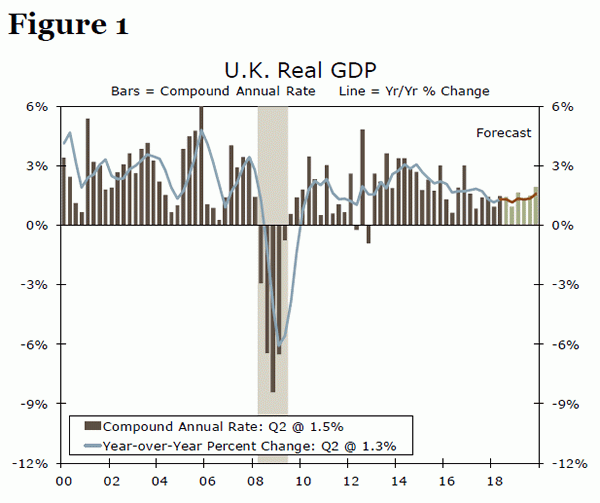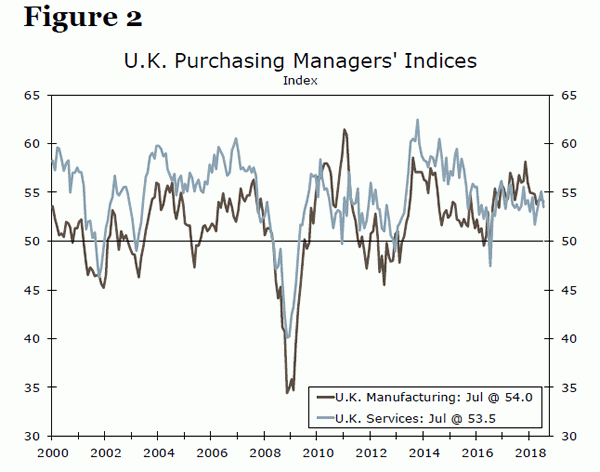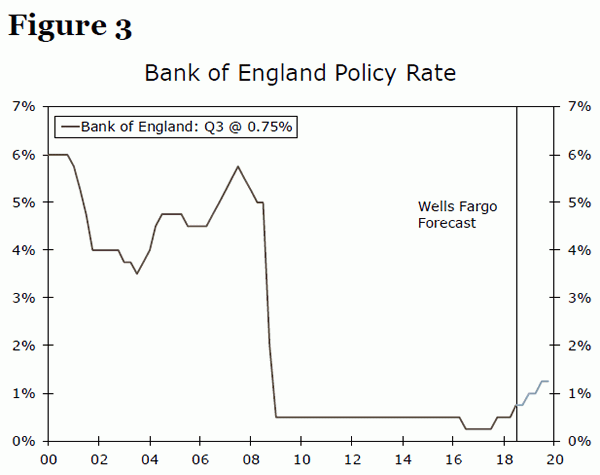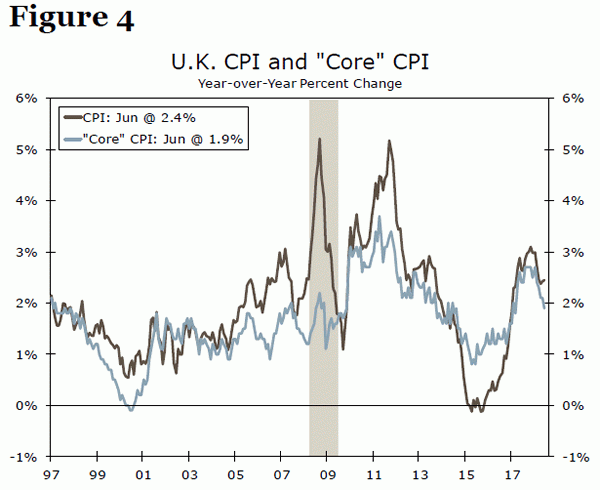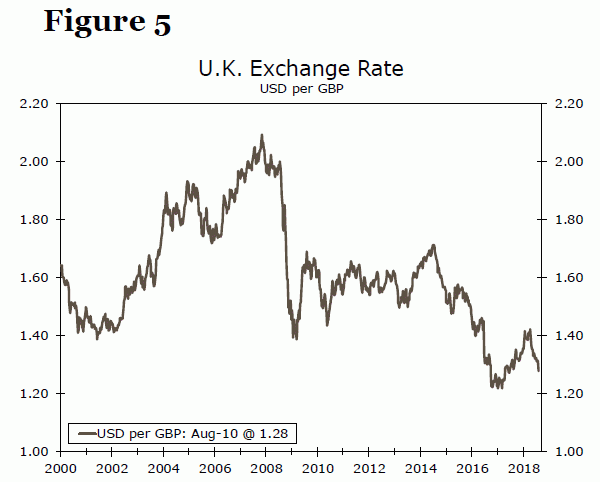Executive Summary
Economic growth in the United Kingdom picked up modestly in Q2 after slowing in the first quarter. Real GDP rose 0.4 percent on a sequential basis, driven by solid growth in consumer and business spending. Inflation in the U.K. has also returned closer to the Bank of England’s (BoE) 2 percent target in recent months after surpassing 3 percent in the wake of the Brexit referendum in 2016. Real wages now look poised to pick up and, along with a tight labor market, should continue to support consumer spending going forward. While growth in domestic demand remained solid in Q2, export growth dropped into negative territory. However, solid global economic growth in the second half of the year should prove a positive for international trade in the U.K., and we look for overall GDP growth to continue to grind higher this year and into 2019.
But Brexit remains the elephant in the room, as uncertainty has increased recently on whether the U.K. and European Union can iron out the future of their economic and financial relationships by the March 2019 deadline. The possibility that negotiations break down and a “hard” Brexit occurs next year poses a substantial downside risk to our forecast of sustained economic growth in the U.K., given the extensive trade and financial ties between the two economies. Uncertainties surrounding negotiations also have the potential to weigh on investment spending, which has already slowed in the wake of the initial referendum in 2016. For now, our brighter outlook for the future of the U.K. economy is based on the assumption that a “hard” Brexit does not come to pass. Should this be the case, we look for the BoE to continue to tighten policy, albeit at a very gradual pace. Inflation has already come back toward target, and higher debt-servicing costs for U.K. households also pose a risk to consumer spending. Brexit-related concerns remain on the horizon, and the BoE will likely proceed with caution until some of these uncertainties subside.
U.K. GDP Rebounds Modestly in Q2 after Sluggish First Quarter
Data released today showed that real GDP in the United Kingdom grew 0.4 percent on a sequential basis (1.5 percent at an annualized rate) in Q2-2018 (Figure 1). The outturn represents a modest strengthening in growth relative to the 0.2 percent rate that was registered in the first quarter; however, the economy has only grown a relatively slow pace over the past several quarters. That said, a breakdown of the real GDP data into its underlying demand components showed that several sectors of the economy made a comeback in Q2. Consumer spending rose 0.3 percent in the quarter. As inflation has receded in recent months, which we discuss in more detail below, there are signs that real wage growth is beginning to pick up. Higher real wages along with a tight labor market–the unemployment rate is currently at a 43 year low—should support growth in consumer spending in coming quarters.
Investment spending was also a notable standout, rebounding 0.8 percent in the quarter after growth dropped into negative territory in Q1. While business fixed investment has decelerated in the wake of Brexit-related uncertainties, the Q2 rebound is supportive for near-term GDP growth prospects. Although consumer spending and business fixed investment proved to be bright spots in today’s print, international trade was a drag on topline GDP growth. Exports dropped 3.6 percent after posting flat growth in Q1, and imports also declined in the quarter. That said, solid global economic growth in the second half of the year should be supportive of a resurgence in external demand.
There is not much “hard” data yet from the third quarter, but some “soft” economic indicators suggest that U.K. GDP growth has remained positive thus far in Q3. For example, the respective purchasing managers’ indices from the manufacturing and service sectors remained well above the demarcation line separating expansion from contraction in July (Figure 2). Our forecast looks for real GDP in the United Kingdom to continue to grow at a modest rate through at least the end of the year before accelerating somewhat in 2019 (Figure 1). Although the Bank of England has hiked its main policy rate 50 bps since last November, monetary policy generally remains accommodative and it is not yet restraining economic activity. Solid economic growth in most of the U.K.’s major trading partners should continue to support growth in British exports for the foreseeable future. That said, there is a significant downside risk to our U.K. GDP forecast, a topic to which we now turn.
Brexit: The Elephant in the Room
Our forecast of continued economic expansion in the United Kingdom is conditional on our assumption that a “hard” Brexit does not occur on March 29, 2019.1 Specifically, we assume that the trading relationship that the United Kingdom currently enjoys with the other 27 members of the European Union (EU-27) will be maintained for approximately two years after March 2019, which will allow negotiators to hammer out the details of a new trading relationship. But the assumption of a smooth transition to a new trading relationship is by no means assured. There is little consensus within the British government about the U.K.’s future relationship with the European Union, and negotiators from the United Kingdom and the EU-27 have made little progress to date. Negotiations could ultimately break down, and a “hard” Brexit could potentially occur in March 2019.
The United Kingdom has extensive trade and financial ties with the European Union. Last year, the United Kingdom sent £164 billion (roughly $215 billion) of exports of goods to the EU-27, which is equivalent to about 8 percent of U.K. GDP. An additional £110 billion (about $140 billion) worth of services were exported to the EU-27 in 2017. The U.K. economic outlook would darken if a “hard” Brexit were to occur and the EU-27 imposed tariffs and other trade restrictions on £275 billion worth of British exports of goods and services.
Moreover, the current uncertainty regarding the ultimate trading relationship and the economic outlook could lead U.K. businesses to mothball investment decisions until more visibility is at hand. Indeed, growth in business fixed investment (BFI) spending has slowed already. BFI was essentially flat in 2016, the year of the Brexit referendum, and it grew only 1.6 percent last year. In contrast, BFI grew at an average rate of 4.5 percent per annum in 2014 and 2015. Growth in investment spending likely will remain sluggish until some of the uncertainty about the long-run trading relationship that the United Kingdom will maintain with the EU-27 is cleared up. A “hard” Brexit could lead to an outright drop in BFI spending.
Bank of England Likely Will Tighten Further, But Only Slowly
Assuming that our forecast of continued economic growth in the United Kingdom comes to pass, we would look for the Bank of England to continue tightening monetary policy at a gradual pace (Figure 3). The Monetary Policy Committee (MPC) lifted the Bank’s main policy rate 25 bps on August 2, which we think was the one and only rate hike that it will undertake in 2018. But we forecast that the MPC will tighten further next year with a 25 bps rate hike in the first quarter of 2019 and another one in the third quarter.
So why will the MPC tighten policy only gradually? For starters, the BoE is tasked by the U.K. government with hitting an inflation target of 2 percent. CPI inflation shot higher in 2017 as the sharp depreciation of sterling in the aftermath of the Brexit referendum lifted import prices (Figure 4). However, inflation has been receding back toward target in recent months, so the MPC probably does not need to tighten policy sharply in order to stabilize inflation expectations.
Secondly, most mortgages in the United Kingdom have some sort of floating-rate structure, and large changes in interest rates lead to meaningful changes in debt-servicing costs among households. Everything else equal, the MPC would want to tighten policy at a gradual pace to guard against the possibility of an abrupt deceleration in consumer spending due to rising debtservicing burdens.
The British pound has depreciated modestly versus the U.S. dollar since April as the greenback has enjoyed general strength versus most currencies (Figure 5). Looking forward, our currency strategy team expects that sterling will slowly trend higher versus the dollar in coming quarters. Although the U.S. Federal Reserve will likely continue to tighten monetary, rates hikes by other central banks, including the BoE, should lend support to most foreign currencies, including the British pound.
Conclusion
Real GDP in the United Kingdom rose 0.4 percent in Q2 after a marked slowdown earlier this year. Several sectors of the economy performed solidly in the quarter, with notable increases in consumer spending and business fixed investment. While trade proved a drag on Q2 GDP growth, solid global growth through the remainder of this year should be supportive of a rebound in external demand. That said, Brexit remains the elephant in the room, as uncertainty has increased in recent weeks on whether the U.K. and European Union can reach an agreement on the future of their economic and financial relationships by the March 2019 deadline. A “hard” Brexit, which could occur if negotiations break down, poses a significant downside risk to our outlook for the U.K. economy. For now, our forecast of continued economic growth in the U.K. is contingent on the fact that a “hard” Brexit does not come to fruition. Should these assumptions remain intact, we look for the BoE to continue to slowly tighten policy in the coming quarters as economic growth also picks up.
1 A “hard” Brexit would occur if the United Kingdom leaves the European Union on March 29, 2019 with no agreements in place. In that event, the rules and regulations governing trade in goods and services between the United Kingdom and the EU-27 would be similar to the current rules between a non-EU country, say the United States, and the European Union.




